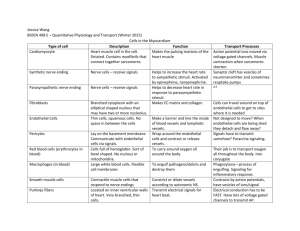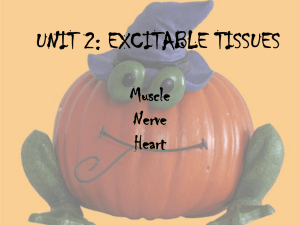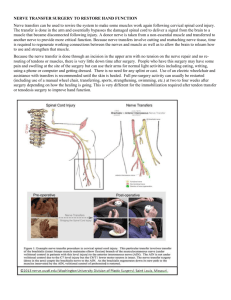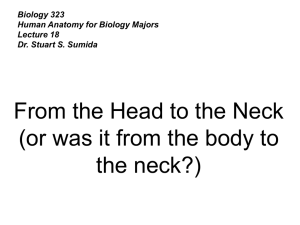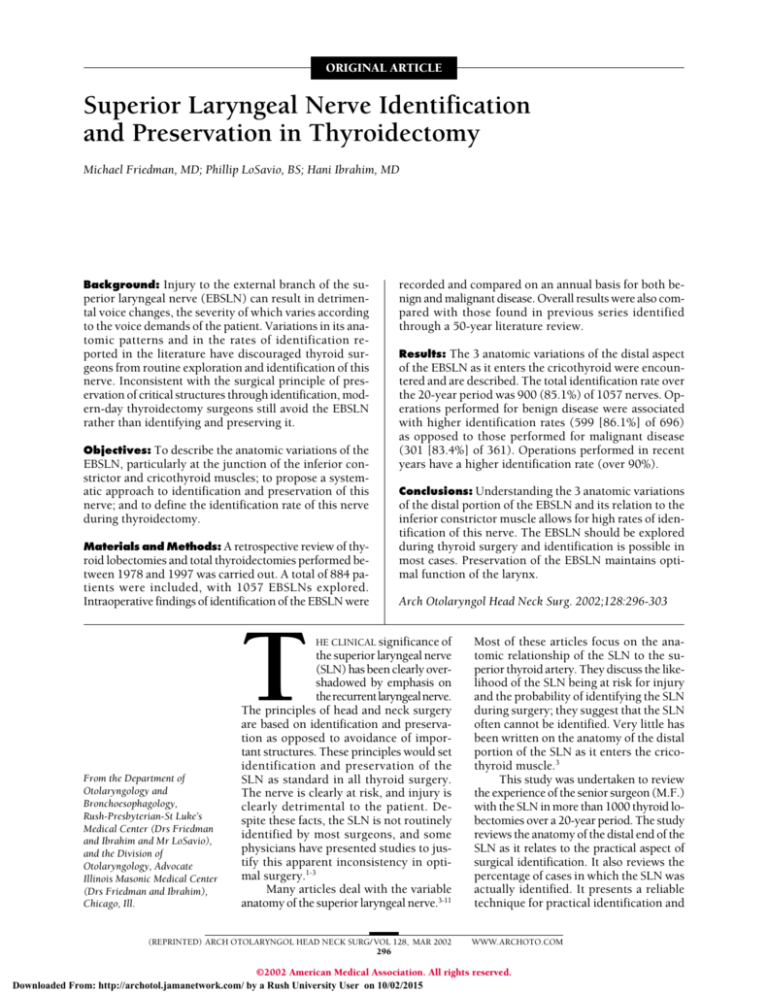
ORIGINAL ARTICLE
Superior Laryngeal Nerve Identification
and Preservation in Thyroidectomy
Michael Friedman, MD; Phillip LoSavio, BS; Hani Ibrahim, MD
Background: Injury to the external branch of the superior laryngeal nerve (EBSLN) can result in detrimental voice changes, the severity of which varies according
to the voice demands of the patient. Variations in its anatomic patterns and in the rates of identification reported in the literature have discouraged thyroid surgeons from routine exploration and identification of this
nerve. Inconsistent with the surgical principle of preservation of critical structures through identification, modern-day thyroidectomy surgeons still avoid the EBSLN
rather than identifying and preserving it.
Objectives: To describe the anatomic variations of the
EBSLN, particularly at the junction of the inferior constrictor and cricothyroid muscles; to propose a systematic approach to identification and preservation of this
nerve; and to define the identification rate of this nerve
during thyroidectomy.
Materials and Methods: A retrospective review of thyroid lobectomies and total thyroidectomies performed between 1978 and 1997 was carried out. A total of 884 patients were included, with 1057 EBSLNs explored.
Intraoperative findings of identification of the EBSLN were
T
From the Department of
Otolaryngology and
Bronchoesophagology,
Rush-Presbyterian-St Luke’s
Medical Center (Drs Friedman
and Ibrahim and Mr LoSavio),
and the Division of
Otolaryngology, Advocate
Illinois Masonic Medical Center
(Drs Friedman and Ibrahim),
Chicago, Ill.
recorded and compared on an annual basis for both benign and malignant disease. Overall results were also compared with those found in previous series identified
through a 50-year literature review.
Results: The 3 anatomic variations of the distal aspect
of the EBSLN as it enters the cricothyroid were encountered and are described. The total identification rate over
the 20-year period was 900 (85.1%) of 1057 nerves. Operations performed for benign disease were associated
with higher identification rates (599 [86.1%] of 696)
as opposed to those performed for malignant disease
(301 [83.4%] of 361). Operations performed in recent
years have a higher identification rate (over 90%).
Conclusions: Understanding the 3 anatomic variations
of the distal portion of the EBSLN and its relation to the
inferior constrictor muscle allows for high rates of identification of this nerve. The EBSLN should be explored
during thyroid surgery and identification is possible in
most cases. Preservation of the EBSLN maintains optimal function of the larynx.
Arch Otolaryngol Head Neck Surg. 2002;128:296-303
HE CLINICAL significance of
the superior laryngeal nerve
(SLN) has been clearly overshadowed by emphasis on
therecurrentlaryngealnerve.
The principles of head and neck surgery
are based on identification and preservation as opposed to avoidance of important structures. These principles would set
identification and preservation of the
SLN as standard in all thyroid surgery.
The nerve is clearly at risk, and injury is
clearly detrimental to the patient. Despite these facts, the SLN is not routinely
identified by most surgeons, and some
physicians have presented studies to justify this apparent inconsistency in optimal surgery.1-3
Many articles deal with the variable
anatomy of the superior laryngeal nerve.3-11
(REPRINTED) ARCH OTOLARYNGOL HEAD NECK SURG/ VOL 128, MAR 2002
296
Most of these articles focus on the anatomic relationship of the SLN to the superior thyroid artery. They discuss the likelihood of the SLN being at risk for injury
and the probability of identifying the SLN
during surgery; they suggest that the SLN
often cannot be identified. Very little has
been written on the anatomy of the distal
portion of the SLN as it enters the cricothyroid muscle.3
This study was undertaken to review
the experience of the senior surgeon (M.F.)
with the SLN in more than 1000 thyroid lobectomies over a 20-year period. The study
reviews the anatomy of the distal end of the
SLN as it relates to the practical aspect of
surgical identification. It also reviews the
percentage of cases in which the SLN was
actually identified. It presents a reliable
technique for practical identification and
WWW.ARCHOTO.COM
©2002 American Medical Association. All rights reserved.
Downloaded From: http://archotol.jamanetwork.com/ by a Rush University User on 10/02/2015
MATERIALS AND METHODS
This nonrandomized retrospective study reviews a 20year experience of thyroid lobectomies from the year 1978
to 1997. The charts of all patients who underwent thyroidectomy and/or lobectomy were reviewed to assess if the external branch of the SLN (EBSLN) was identified and preserved or not identified at surgery. Cases were categorized
into benign or malignant as determined by pathology reports at the time of surgery, and the percent identification
was compared for each calendar year. Overall, 884 patient
cases were reviewed with a total of 1057 EBSLNs put at risk
(696 nerves [65.8%] in cases with benign tumors and 361
nerves [34.2%] with malignant tumors). A full literature
search was performed on the OVIDWEB-MEDLINE database looking for all relevant articles since 1950 that comment on the identification, preservation, anatomy, surgical technique, and injury rate to the EBSLN.
SURGICAL ANATOMY
The SLN is classically described as originating from the
middle of the nodose ganglion. In addition, it receives
contributions from the superior cervical sympathetic ganglion. Its path of descent initially begins posteriorly and
proceeds medially to the internal carotid artery where it
bifurcates into an internal (sensory and autonomic) and
external laryngeal branch (motor). 12,13 The internal
branch proceeds to pierce the thyrohyoid membrane with
the superior laryngeal artery and subsequently divides
into an upper and lower branch. The external branch continues to travel inferiorly, passing superficially to the inferior constrictor and then piercing it to finally reach the
cricothryoid muscle.12 While this level of description can
suffice for the nonsurgical observer, more detailed
descriptions have helped to elucidate the variations in the
anatomy of the EBSLN to aid the surgeon operating in
this area.3-11
This study focused on the anatomy of the EBSLN at
its insertion into the cricothyroid muscle. Terminal
branches of the EBSLN penetrate the horizontal and
oblique bellies of the cricothyroid muscle as well as the
inferior constrictor. However, 3 variations have been
described for the main trunk of the EBSLN prior to its terminal branching. In the type 1 variation, it runs its whole
course superficially or laterally to the inferior constrictor,
descending with the superior thyroid vessels until it terminates in the cricothyroid muscle (Figure 1). In the type 2
variation, the EBSLN penetrates the inferior constrictor in
the lower portion of the muscle (Figure 2). In this case it
is only partially protected by the inferior constrictor. And
finally, the type 3 nerve dives under the superiormost
fibers of the inferior constrictor, remaining covered by this
muscle throughout its course to the cricothyroid muscle
(Figure 3).
Often the SLN is not easily visible, and some authors
consider these situations ones of “unidentifiable nerves.”1-3
These authors believe that if the course of the distal branch
runs under the inferior constrictor muscle (which occurs
in 20% of cases3), the nerve is unidentifiable. In fact, we
have found that in most of these situations the nerve can
be identified by nerve stimulation along the border of the
inferior constrictor and the cricothyroid (type 3, Figure 3).
The muscle response of the stimulated nerve is quite different than the response of direct muscle stimulation. Absence of identification by stimulation should direct the surgeon back to the region of the vessels to search for a missed
type 1 nerve.
This classification is based on the terminal aspect of
the EBSLN and is provided as a practical guide for identification. It does not replace previously described classifications by Kierner et al4 and Cernea et al5 that focus on the
EBSLN and the superior thyroid vessels’ relationship. The
percentage of patients with anatomy corresponding to 1 of
these 3 types has not been studied in detail by us or by other
investigators. Lennquist et al3 studied the percentage of their
patients with type 3 distribution and found it to be 20%.
Although the retrospective review of the data was not detailed enough in that study to identify which type was present in every case, all 3 types were frequently identified.
SURGICAL TECHNIQUE
A previously described systematic approach14 was used
consistently in all of our cases. After raising subplatysmal
flaps, care was taken to maintain meticulous hemostasis
as the sternohyoid and sternothyroid muscles were individually elevated laterally (Figure 4 and Figure 5). The
sternohyoid muscle was elevated laterally up to the hyoid
to allow visualization of the sternothyroid muscle insertion into the oblique line of the thyroid cartilage. The
sternothyroid muscle was then elevated laterally until the
lateral edge of the thyroid gland was reached. The medial
edge of the superior attachment of the sternothyroid
muscle was transected with a bipolar cautery for a distance of 5 mm (Figure 6), which provided better exposure of the inferior constrictor–cricothyroid junction. The
horizontal and oblique bellies of the cricothyroid muscle
were identified as was the anterior edge of the inferior
constrictor.
A disposable nerve stimulator (set on 2 mA) was used
to identify the terminal branches of the EBSLN as they enter the cricothyroid bellies. The stimulator was first used
directly on the cricothyroid muscle to assess the response
of direct muscle stimulation. This helps differentiate muscle
stimulation from nerve stimulation. If the EBSLN was identified over the inferior constrictor (type 1, Figure 1), it was
followed in a retrograde direction. Identification of the nerve
in this location allows for preservation of the nerve. This
anatomic variant is usually associated with an EBSLN that
crosses the superior thyroid artery at or below the superior thyroid pole. This scenario places the nerve at risk not
only during ligation of the superior thyroid vessels but during dissection of the loose areolar tissue adjacent to the superior pole. Routinely, the superior pole vessels and the loose
areolar tissue surrounding them are not dissected until the
EBSLN is explored. In some cases, the EBSLN can be identified crossing some of the inferior constrictor and then diving under the muscle for a variable distance prior to its insertion in the cricothyroid muscle (type 2, Figure 2). Once
this nerve is identified, no further dissection is usually
needed.
The EBSLN is considered at risk in each patient until
it is identified. The nerve is stimulatable in almost all cases
at the junction of the cricothyroid and inferior constrictor
muscles. Identification by stimulation assures the surgeon that the nerve is not at risk.
(REPRINTED) ARCH OTOLARYNGOL HEAD NECK SURG/ VOL 128, MAR 2002
297
WWW.ARCHOTO.COM
©2002 American Medical Association. All rights reserved.
Downloaded From: http://archotol.jamanetwork.com/ by a Rush University User on 10/02/2015
Type 1
Superior Thyroid Artery (Red) and Vein
Superior Laryngeal Nerve External
Branch
Inferior Pharyngeal
Constrictor Muscle
Sternohyoid Muscle
(Cut)
Cricothyroid Muscle
Cricopharyngeus Muscle
Thyroid Gland
Figure 1. Type 1 anatomic variant: the external branch of the superior laryngeal nerve runs superficially to the inferior constrictor muscle.
preservation of the SLN in thyroid surgery in a high percentage of cases.
RESULTS
Table 1 summarizes the results of our study. The identification and preservation rate in 884 patients over 20
years, with a total of 1057 nerves at risk, was 85.1%
(900/1057). The identification rates were calculated annually from 1978 to 1997. In later years, the use of stimulation to identify the EBSLN covered by the inferior constrictor helped increase the identification rate from 75%
in 1978 to 90% in 1997.
COMMENT
Identification of the EBSLN has become a standard
practice in all thyroid lobectomies performed by one
of us (M.F.). The aforementioned technique of distal
identification at the inferior constrictor–cricothyroid
junction has resulted in an average identification rate
of 85.1% over the past 20 years, with recent years demonstrating a higher than 90% success rate. Although the
absence of patient complaints and abnormal laryngeal
examination findings postoperatively allowed the
authors to assume a lower injury rate, no specific studies were routinely performed to confirm this assumption. The purpose of the study was not to establish
an injury rate but to review the anatomy and establish
the identification rate attainable with routine thyroid
surgery.
The importance of avoiding injury to the EBSLN
should not be understated when discussing the sequelae of complications during thyroid surgery. Paralysis of the SLN can be significant to those whose career
depends heavily on full range of voice. One of the earliest reported cases goes back to 1935 when famous
opera singer Amelita Galli-Curci suffered injury to her
EBSLN after thyroid surgery with devastating consequences.15
(REPRINTED) ARCH OTOLARYNGOL HEAD NECK SURG/ VOL 128, MAR 2002
298
WWW.ARCHOTO.COM
©2002 American Medical Association. All rights reserved.
Downloaded From: http://archotol.jamanetwork.com/ by a Rush University User on 10/02/2015
Type 2
Superior Thyroid Artery (Red) and Vein
Superior Laryngeal Nerve External
Branch
Inferior Pharyngeal
Constrictor Muscle
Cricothyroid Muscle
Cricopharyngeus Muscle
Thyroid Gland
Figure 2. Type 2 anatomic variant: the external branch of the superior laryngeal nerve dives deep to the inferior constrictor muscle, approximately 1 cm proximal
to the inferior constrictor–cricothyroid junction.
Damage to the nerve can manifest as ipsilateral
paralysis to the cricothryoid muscle as demonstrated
by electromyography (EMG) and fiberoptic stroboscopic laryngoscopy.16,17 Clinical symptoms may present as a hoarse, breathy voice, increased throat clearing, vocal fatigue, or diminished vocal frequency
range, especially in regard to raising pitch. The clinician may find signs of bowing and inferior displacement of the affected cord on examination.16 Two anatomic studies on cadavers6,7 using special staining to
map out nerve distributions and patterns around
the larynx have demonstrated communicating nerves
between the EBSLN and the recurrent laryngeal nerve.
They suggest that the EBSLN may contribute significant innervation to other muscles beyond the
cricothyroid adding to the evidence of this nerve’s
importance.
Identification and injury rates have varied greatly
across different studies, with identification rates ranging
from 33% to 93%, while injury rates have been reported
between 0% and 58%1-3,8,16,18-21 (Table 2). The variation in results is partially explained by the nonconcordance of surgical techniques used by different physicians. In many circumstances, inaccuracy of evaluation
techniques has also most likely resulted in underreported EBSLN injury rates. Jansson et al18 reported that
partial SLN lesions could not be diagnosed reliably
based on indirect laryngoscopy or voice symptoms.
They pointed to EMG as a much more definitive
method of making a diagnosis. Unfortunately, many
studies to date have not used EMG when reporting
injury rates.1-3,19,20
Another important factor to consider is that published injury rates may not be applicable to the average
surgeon in every circumstance. As demonstrated by Cernea et al,8 training level played a significant role in correlating with injury rates, with residents recording a 28%
injury rate and the senior author (Claudio R. Cernea,
(REPRINTED) ARCH OTOLARYNGOL HEAD NECK SURG/ VOL 128, MAR 2002
299
WWW.ARCHOTO.COM
©2002 American Medical Association. All rights reserved.
Downloaded From: http://archotol.jamanetwork.com/ by a Rush University User on 10/02/2015
Type 3
Superior Thyroid Artery (Red) and Vein
Superior Laryngeal Nerve External
Branch
Inferior Pharyngeal
Constrictor Muscle
Cricothyroid
Muscle
Cricopharyngeus Muscle
Thyroid Gland
Figure 3. Type 3 anatomic variant: the external branch of the superior laryngeal nerve runs deep to the inferior constrictor muscle.
MD) reporting only a 12% rate. Lore et al2 argue that it
is not necessary to avoid the nerve to avoid injuring it.
They point out that many of the existing studies show
similar rates of injury whether the nerve is located or
not. In their own series they report an extremely low
injury rate. In spite of this, it is an accepted surgical
principle that identification is the key to preservation of
structures at risk.
Variability in the anatomy of the EBSLN as it
relates to the superior thyroid artery has been studied
in detail.3-5,8-11 Cernea et al5 were among the first to describe a specific classification system (types 1, 2a, or
2b); they found the percentage of each pattern to vary
among patients with either small or large goiters
owing to the alteration in the anatomic arrangement
that takes place with enlargement of the thyroid gland.
Kierner et al4 revisited this subject with cadaver studies and refined the nomenclature, taking into account
the cases that Cernea and colleagues5 labeled as “not
identified” (Table 3). Type 2b (which correlates with
our described type 1 pattern) is at the highest risk during surgery, with the categories in which the nerve
crosses relatively high to the upper thyroid pole being
at considerably less risk of iatrogenic injury. This fact,
however, should not preclude one from identifying
all circumstances in which the nerve presents itself.
Indeed, the rate of 2b variants is significantly increased in cases of disease caused by superior displacement of the upper thyroid pole.5 Cernea et al5 reported
a difference of 54% vs 14% in cases of large and small
goiters, respectively. When the surgeon ligates the
superior pole vessels and has not identified the
EBSLN, it cannot be assumed that it is a high-crossing
variant and therefore not at risk. Negative findings
could always prove to be a case of a 2b nerve that has
yet to be successfully located. At the same time, it is
unreasonable for one to expand the surgical field
superiorly to unquestionably identify these other variants higher in the neck. We propose our system that
concentrates not on the superior thyroid vessels, but
(REPRINTED) ARCH OTOLARYNGOL HEAD NECK SURG/ VOL 128, MAR 2002
300
WWW.ARCHOTO.COM
©2002 American Medical Association. All rights reserved.
Downloaded From: http://archotol.jamanetwork.com/ by a Rush University User on 10/02/2015
Thyrohyoid Muscle
Sternohyoid Muscle
Sternothyroid Muscle
Omohyoid Muscle
Sternohyoid
Muscle
Sternothyroid
Muscle
Figure 4. Strap muscles.
on the presentation of the nerve in the inferior
constrictor–cricothyroid junction with subsequent retrograde dissection and preservation.
Only the clinical and anatomic studies of this
region by Lennquist et al3 have described in detail the
relationship of the EBSLN with its entry into the cricothyroid muscle. They point to the fact that in nearly
20% of cases the nerve is buried in the fibers of the inferior pharyngeal constrictor and thus not identifiable
without dissection of the fibers. They argue that in
these cases where the nerve is covered by constrictor
fibers greater than 10 cm proximal to cricothyroid
entry, more harm than good will result from a search
for the nerve.3 Our technique, however, does not subject the constrictor fibers to a destructive reconnaissance mission because we limit our dissection to the
junction between the 2 muscles. Positive identification
of the nerve at the junction of the inferior constrictor
and cricothyroid muscles can be accomplished in most
cases with minimal dissection. This increases the overall identification rate.
In conclusion, preservation of the EBSLN is
important for optimal function of the larynx. The
nerve is at risk during thyroidectomy, and although
injury rates are not clearly established, they do exist.
The principles of head and neck surgery dictate that
the best way to avoid injury to a structure at risk is by
identification and preservation. The EBSLN has not
been routinely identified because of conflicting data
on the ability and rate of intraoperative identification.
This study establishes an identification rate of over
85% based on a simple technique combined with
detailed knowledge of the anatomy of the terminal
Figure 5. The sternohyoid muscle is dissected laterally up to the hyoid bone
to allow visualization of the sternothyroid muscle and its attachment to the
oblique line.
Thyrohyoid Muscle
Sternohyoid Muscle
Sternothyroid Muscle
Cricothyroid
Muscle
Figure 6. If the inferior constrictor–cricothyroid junction is not clearly visible
by retraction of the sternothyroid, the medial 5-mm attachment of the
sternothyroid is transected.
branches of the EBSLN. Routine identification and
preservation is possible in most thyroidectomy procedures.
(REPRINTED) ARCH OTOLARYNGOL HEAD NECK SURG/ VOL 128, MAR 2002
301
WWW.ARCHOTO.COM
©2002 American Medical Association. All rights reserved.
Downloaded From: http://archotol.jamanetwork.com/ by a Rush University User on 10/02/2015
Table 1. EBSLN* Identification (ID) and Preservation Rates for Benign and Malignant Disease
Benign
Malignant
Year
No. of
Patients
No. of Nerves
Identified
No. of Nerves
at Risk
ID Rate, %
No. of Nerves
Identified
No. of Nerves
at Risk
ID Rate, %
1978
1979
1980
1981
1982
1983
1984
1985
1986
1987
1988
1989
1990
1991
1992
1993
1994
1995
1996
1997
Total
17
26
29
43
48
40
45
41
42
41
42
44
51
54
54
49
54
51
61
52
884
10
14
13
30
32
30
30
26
26
31
27
32
34
36
33
27
40
38
48
42
599
12
19
19
37
36
35
35
29
31
37
35
36
40
43
40
32
42
41
51
46
696
83.33
73.68
68.42
81.08
88.89
85.71
85.71
89.66
83.87
83.78
77.14
88.89
85
83.72
82.5
84.38
95.24
92.68
94.12
91.3
86.06
6
8
10
12
14
11
15
14
14
13
12
15
16
17
24
23
17
18
24
18
301
8
11
14
15
18
14
17
17
17
16
14
18
18
21
30
28
18
20
27
20
361
75
72.73
71.43
80
77.78
78.57
88.24
82.35
82.35
81.25
85.71
83.33
88.89
80.95
80
82.14
94.44
90
88.89
90
83.38
*EBSLN indicates external branch of the superior laryngeal nerve.
Table 2. Reported EBSLN Identification (ID) and Injury Rates*
Source
Evaluation Method
Surgical Technique
ID Rate, %
Injury Rate, %
Jonas and Bahr1
Lore et al2
Teitelbaum and
Wenig16
Cernea et al8
Laryngoscopy, voice evaluation
Laryngoscopy, questioning
EMG, videostroboscopy,
questioning
EMG, voice evaluation
Neuromonitoring to find nerve
Not necessary to expose nerve
No routine ID of nerve
37.8
33
...
4.6 (Temporary)
7.5 (Permanent)
5 (Permanent)
Nerve stimulator compared with no
nerve search done by resident and
attending physicians
93
Jansson et al18
72
2.6 (Due to diathermy error)
Lekacos et al19
Laryngoscopy
...
Kark et al20
Laryngoscopy, oscilloscopy,
questioning
Laryngoscopy, voice evaluation
No routine technique to identify
superior laryngeal nerve
Inspection of distal part of constrictor
for nerve but no muscle dissection
Separately ligate superior pole vessels;
no nerve exposure
Looked at nerve ID vs without nerve ID
...
Lennquist et al3
EMG, indirect laryngoscopy,
voice evaluation
Laryngoscopy, questioning
0 (Attending physician, nerve search
attempted),
12 (Attending physician, no nerve
search),
28 (Resident physician, no nerve search)
58 (Temporary)
84
5.6 (High ligation of vessels),
0 (Low ligation of vessels)
5 (Nerve search attempted),
3 (Nerve search not attempted)
Tried to identify nerve
59
Reeve et al21
*EBSLN indicates external branch of the superior laryngeal nerve; EMG, electromyography; and ellipses, not applicable.
Table 3. EBSLN Classification Systems*
Cernea et al4
Kierner et al 4
Criteria
Type 1 (68% SG, 23% LG)
Type 2a (11% SG, 15% LG)
Type 2b (14% SG, 54% LG)
Not described
Type 1 (42%)
Type 2 (30%)
Type 3 (14%)
Type 4 (14%)
Crosses STA ⬎1 cm above upper pole
Crosses STA ⬍1 cm above upper pole
Crosses STA under cover of upper pole
Descends dorsal to artery and crosses STA branches immediately above upper pole
*EBSLN indicates external branch of the superior laryngeal nerve; SG, small goiters; LG, large goiters; and STA, superior thyroid artery.
(REPRINTED) ARCH OTOLARYNGOL HEAD NECK SURG/ VOL 128, MAR 2002
302
WWW.ARCHOTO.COM
©2002 American Medical Association. All rights reserved.
Downloaded From: http://archotol.jamanetwork.com/ by a Rush University User on 10/02/2015
Accepted for publication November 15, 2001.
This study was presented at the annual meeting of the
American Head and Neck Society, Palm Desert, Calif, May
16, 2001.
Corresponding author: Michael Friedman, MD, 30 N
Michigan Ave, Suite 1107, Chicago, IL 60612 (e-mail:
khender213@aol.com).
Reprints: Michael Friedman, MD, Department of
Otolaryngology and Bronchoesophagology, RushPresbyterian-St Luke’s Medical Center, 1653 W Congress
Pkwy, Chicago, IL 60612-3833.
REFERENCES
1. Jonas J, Bahr R. Neuromonitoring of the EBSLN during thyroid surgery. Am J
Surg. 2000;179:234-236.
2. Lore JM, Kokocharov SI, Kaufman S, Richmond A, Sundquist N. 38-Year evaluation of a surgical technique to protect the EBSLN during thyroidectomy. Ann
Otol Rhinol Laryngol. 1998;107:1015-1022.
3. Lennquist S, Cahlin C, Smeds S. The superior laryngeal nerve in thyroid surgery. Surgery. 1987;102:999-1008.
4. Kierner AC, Aigner M, Burian M. The EBSLN: its topographical anatomy as related
to surgery of the neck. Arch Otolaryngol Head Neck Surg. 1998;124:301-303.
5. Cernea CR, Nishio S, Hojaij FC. Identification of the EBSLN in large goiters. Am
J Otol. 1995;16:307-311.
6. Wu BL, Sanders I, Mu L, Biller HF. The human communicating nerve: an extension of the EBSLN that innervates the vocal cord. Arch Otolaryngol Head Neck
Surg. 1994;120:1321-1328.
7. Sanders I, Wu BL, Mu L, Youzhu L, Biller HF. The innervation of the human larynx. Arch Otolaryngol Head Neck Surg. 1993;119:934-939.
8. Cernea CR, Ferraz AR, Furlani J, et al. Identification of the EBSLN during thyroidectomy. Am J Surg. 1992;164:634-639.
9. Moosman DA, DeWeese MS. The external laryngeal nerve as related to thyroidectomy. Surg Gynecol Obstet. 1968;127:1011-1016.
10. Durham CF, Harrison TS. The surgical anatomy of the superior laryngeal nerve.
Surg Gynecol Obstet. 1964;118:38-44.
11. Cernea CR, Ferraz AR, Nishio S, Dutra A, Hojaij FC, Medina dos Santos LR. Surgical anatomy of the EBSLN. Head Neck. 1992;14:380-383.
12. Williams PL, Bannister LH, Berry MM, et al. In: Williams P, Dyson M, Bannister
LH, et al, eds. Gray’s Anatomy. 38th ed. New York, NY: Churchill Livingstone;
1995.
13. Moore KL. Clinically Oriented Anatomy. 3rd ed. Baltimore, Md: Williams & Wilkins;
1992.
14. Friedman M, Toriumi DM. Functional identification of the external laryngeal nerve
during thyroidectomy. Laryngoscope. 1986;96:1291-1292.
15. Eisele DW, Goldstone AC. Electrophysiologic identification and preservation of
the superior laryngeal nerve during thyroid surgery. Laryngoscope. 1991;101:
313-315.
16. Teitelbaum BJ, Wenig BL. Superior laryngeal nerve injury from thyroid surgery.
Head Neck. 1995;17:36-40.
17. Abelson TI, Tucker HM. Laryngeal findings in SLN paralysis: a controversy. Otol
Head Neck Surg. 1981;89:463-470.
18. Jansson S, Tisell L, Hagne I, Sanner E, Stenborg R, Svensson P. Partial SLN lesions before and after thyroid surgery. World J Surg. 1988;12:522-527.
19. Lekacos NL, Miligos ND, Tzardis PJ, Majiatis S, Patoulis J. The SLN in thyroidectomy. Am Surg. 1987;53:610-612.
20. Kark AE, Kissin MW, Auerbach R, Meikle M. Voice changes after thyroidectomy:
role of the external laryngeal nerve. BMJ. 1984;289:1412-1415.
21. Reeve TS, Coupland GAE, Johnson DC, Buddee FW. The recurrent and external
laryngeal nerves in thyroidectomy. Med J Aust. 1969;1:380-382.
(REPRINTED) ARCH OTOLARYNGOL HEAD NECK SURG/ VOL 128, MAR 2002
303
WWW.ARCHOTO.COM
©2002 American Medical Association. All rights reserved.
Downloaded From: http://archotol.jamanetwork.com/ by a Rush University User on 10/02/2015



